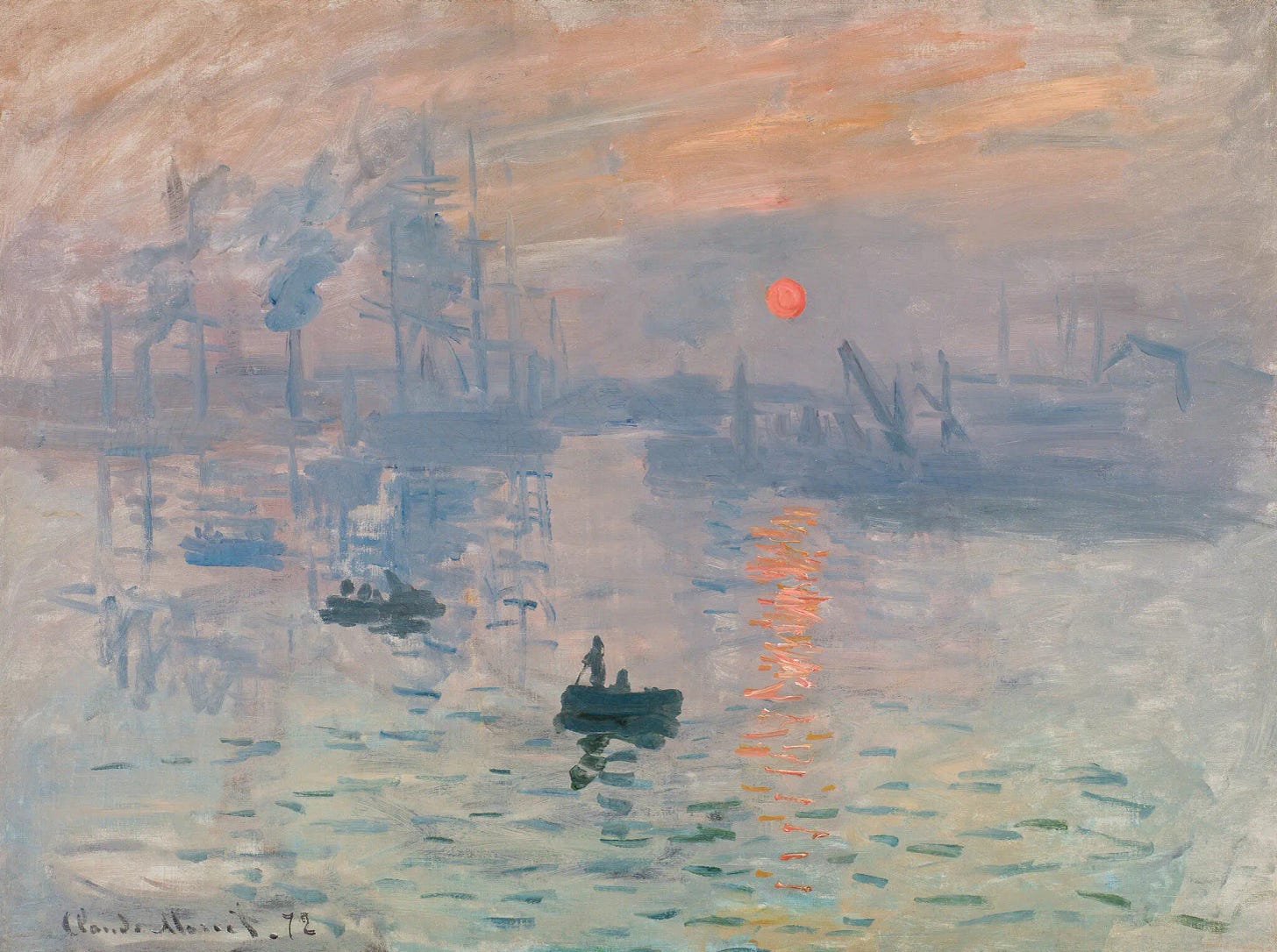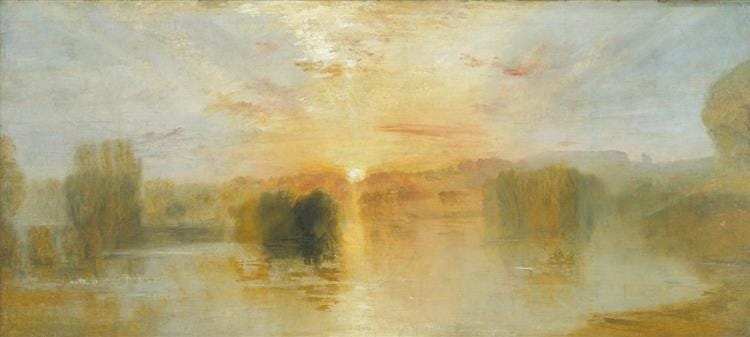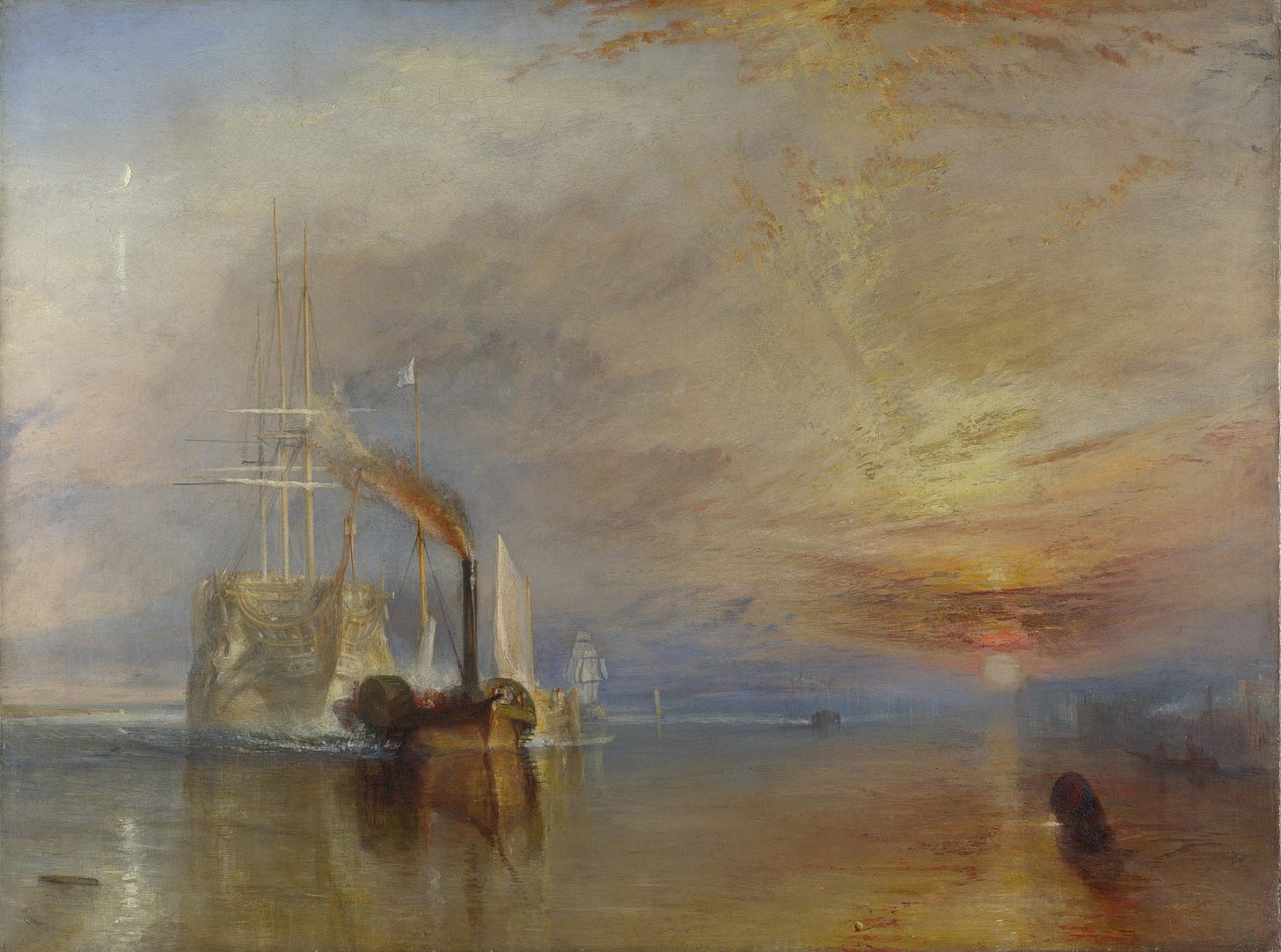A week ago, N.Y. Times critic-at-large Jason Farago published “How the Impressionists Became the World’s Favorite Painters, and the Most Misunderstood Exactly 150 years ago, Monet, Degas, Renoir and their pals spurred an artistic revolution. Can we still see the defiance behind the beauty, and the schmaltz?”
It’s a competent piece, providing context for the revolutionary new era in 1870s France following the country’s humiliation at the hands of the Prussians in 1870-71. This was immediately followed by the revolutionary upheaval of the ill-fated Paris Commune, witnessed by Monet, Renoir, Pissarro, Morisot, Degas, Sisley, Cézanne, and Guillemin, core members of the Impressionist revolution who in 1874 mounted an alternative exhibition to the “Salon, the government-sanctioned annual art exhibition that had been France’s (indeed Europe’s) most significant showcase of new art for longer than two centuries.”
Their show was not a runaway success. Only 3,500 people bought tickets. (Attendance at the Salon that year: 400,000.) Some critics trashed the show — impressionism was a critic’s sneer for the whole group, mocking Monet’s sunrise over the sea for lacking composition and finish.
But the show had its defenders. Several receptive critics saw something vital in the lighter colors, the open brushwork. Camille Pissarro would describe his fellow exhibitors as lovers of “nature, the open air, the different impressions that we experience, all the things we are concerned with.” . . .
Farago singles out Monet’s “Impression, Sunrrise” “as among the most famous and influential in all of French art.” In promoting Farago’s article, the Times suggests that Monet’s painting, breaking with the rule-bound traditions of the Academie, launched the revolution in art that followed.
Torn between the Impressionists’ revolutionary substance and rose-tinted schmaltz, Farago asks three questions: “Can we rediscover what was so revolutionary about impressionism back in 1874? Can we still see the defiance in its beauty, and even its schmaltz?” and “Does loving Impressionism make me basic?” To this admission of the guilty pleasure he and surely we derive from loving Impressionism, Farago replies:
Impressionism is all about how we live in that permanent contradiction. That’s what it can teach 21st-century audiences whose hunger for authenticity and antagonism keeps coming up short. And if you find Monet, Renoir, Degas too pretty and popular — if you think Impressionism is the artistic equivalent of a pumpkin spice latte — I want you to taste the espresso beneath the foam.
Nice touch. But I have a bone to pick with Mr. Farago: Like virtually all art critics, he misattributes the origins of Impressionism to the French when, in fact, Impressionism originated half a century earlier in Britain. Moreover, the initial driving force behind the Impressionist revolution was not painters but poets! To prove my point, I share with you the following slightly adapted essay written for an English Lit. class in 1998:
British Romantic Roots of French Impressionism
During the second half of the nineteenth century, the French Impressionists rocked the art world by roaming the countryside painting fuzzy pictures of nature and domestic scenes. Before the Impressionists, painters generally worked in studios illuminated by indirect northern light. Painting methodically within the confines of a studio, lacking strong sunlight and shadow, French Royal Academy painters who ruled the art world before Impressionism predictably created paintings of photographic resolution, dimly lit, in muted colors, usually depicting heroic scenes of antiquity with nature as a background. Landscape painting “suffered from the stigma of inferiority,” being regarded as a “minor pursuit.” Then, the Impressionists invaded the French countryside, towns, and cities, painting their impressions of what they saw in bright, colorful, fuzzy pictures. Rejecting heroic themes and bringing nature vividly to the foreground in seductively accessible form, they created a major turning point in art history. Soon the Impressionist movement outshone the work of those who consigned them to the Paris Salon des Refusés in 1863, opening the way for modern art and, a century later, commanding many millions of dollars more than their predecessors for recognizable works.
British Romantic poets mounted an equivalent insurrection in poetry more than half a century before the Impressionists ventured into the outdoor light and air of France. Abandoning the heroic themes and stilted form of their neoclassical predecessors, Wordsworth and Coleridge created impressionistic word pictures of the English countryside, immortalizing the Lake District in northern Britain around the beginning of the nineteenth century, much as Cezanne and Van Gogh would immortalize Provence in the south of France late in the century. Fire a shot in any direction in the Lake District, and you are bound to hit a British National Treasure, duly marked as having inspired this Wordsworth or that Coleridge poem. The Romantic revolutionaries, using accessible themes and language, displaced their more formal predecessors, expanded poetry’s audience, and opened the way for the realist poets who followed.
Foreshadowing the Impressionists’ practice of creating while out in nature, both Wordsworth and Coleridge experimented with composing out of doors, notably Wordsworth’s Lines, Composed a Few Miles above Tintern Abbey. . . along with Written in March, While Resting on the Bridge at the Foot of Brother’s Water and Composed upon Westminster Bridge, September 3, 1802, and Coleridge’s This Lime-Tree Bower, My Prison. Tintern Abbey stimulates in Wordsworth primarily a reflective, philosophical bent of mind (“that blessed mood / In which the burthen of the mystery. . . is lightened” “the joy of elevated thoughts; a sense sublime”) These thoughts overshadow Wordsworth’s descriptions of nature in the poem. Coleridge’s experience in the lime-tree bower, on the other hand, prompts him to revel in the sensory joy of the moment (“A delight / Comes sudden on my heart”) and create vivid nature imagery, antedating the Impressionists’ fascination with light and shadow:
Pale beneath the blaze
Hung the transparent foliage; and I watched
Some broad and sunny leaf, and loved to see
The shadow of the leaf and stem above
Dappling its sunshine!. . .
Coleridge conveys a haiku-like sense of immediacy about the occasion. He uses various flying creatures to immerse his readers in the scene and the moment: “now the bat / Wheels silently by”. . . “the solitary humblebee / Sings in the bean-flower”. . . “the last rook / Beat its straight path along the dusky air. . . “now a dim speck, now vanishing in light”. The repeated use of “now” associated with the description of a moving creature compellingly induces that sense of temporal immediacy. French Impressionists likewise became famous for capturing small, unheroic moments, whether it be Manet or Degas at the races and the ballet, or Monet by the seashore, for example.
Like the Impressionists, who painted still lifes and portraits indoors (particularly when it rained), Wordsworth and Coleridge also worked indoors, penning their “spontaneous overflow of powerful feelings . . . recollected in tranquility.” In moving indoors, however, both the poets and the painters, retained their emotional, impressionistic styles developed in the light and air of nature. For example, in Work Without Hope Coleridge impressionistically evokes nature en plein air (again using birds and bees) and emotion:
All Nature seems at work. Slugs leave their lair,
The bees are stirring, birds on the wing,
And Winter slumbering in the open air,
Wears on his smiling face a dream of Spring!
And I the while, the sole unbusy thing,
Nor honey make, nor pair, nor build, nor sing.
Wordsworth is similarly expressive in Resolution and Independence:
There was a roaring in the wind all night;
The rain came heavily and fell in floods;
But now the sun is rising calm and bright;
The birds are singing in the distant woods . . .
All things that love the sun are out of doors;
The sky rejoices in the morning’s birth;
The grass is bright with rain-drops; . . .
As high as we have mounted in delight,
In our dejection do we sink so low;
To me that morning did it happen so;
The link between the British Romantic poets and the French Impressionist painters can be traced to the British Romantic landscape painters, notably John Constable and J.M.W. Turner. Both were slightly younger contemporaries of Wordsworth and Coleridge, who painted nature unheroically, sentimentally, en plein air with varying degrees of impressionism. They began producing their most notable works within a few years of the poets’ productive peak, bracketing the turn of the century, five decades before the French ventured outdoors. As educated Britons, Constable and Turner were doubtlessly familiar with and influenced by the poets’ revolutionary works. Underappreciated in Britain, the Romantic landscape painters were highly regarded by French painters, ranging from their contemporaries like Delacroix to the later Impressionists Monet and Pissarro.
In short, by rejecting the heroic themes and stilted style of their predecessors, bringing nature to the fore, and developing their art out of doors, Wordsworth and Coleridge precipitated a virtually identical contemporaneous revolution in painting in Britain, and across the English Channel more than half a century later. In the process, both the British poets and the French painters displaced their predecessors, broadened their audience, and opened the way for further evolution of their art. In a very real sense, therefore, the astronomical sums recently paid for French Impressionist paintings at auctions in New York can be attributed in part to lines penned by two young British poets rhapsodizing in the English countryside two centuries ago.
Epilog: Which of these did Monet paint?
Answer: None. They were painted by J.M.W Turner “Sunset” (1827) and “Rain, Steam, and Speed the Great Western British Railway” (1844), "The Fighting Temeraire, Tugged to Her Last Berth to be Broken Up, 1838." respectively.







I want to see Monet's letter to Turner thanking him for that Wordsworthian shot in the arm.
Failing that, it's another example of academic Whatifism.
Influences between arts and artists have to be grounded in proven fact, not supposition. Granted,academic careers are often guided by supposition - it keeps the academic publishers busy (three readers: one who agrees, one who disagrees, one who considers)...As an artist raised by artists, and who has lived among artists in America, France, England and Italy, I'm often astounded by the supposed revelations of critics, which speak more about the intellectual crossword puzzles of the critics than they do about the artists' work or the artists themselves. Recently, for example, I read a well-known Polish film-critic who analyzed the adaptation of "Pretty Poison" in light of the studio's choices of dramatic shifts; and have laughed at Pauline Kael's remarks about the brilliant dramatic ironies of the screenwriter...In no essay was the writer of the original material even mentioned as - I don't know - perhaps the creator of the material?
I've seen the same thing with painting critics, music critics, drama critics, and have read countless essays and books about Shakespeare's dramatic choices - without one reference to an overheard conversation with Shakespeare and his actors, or Ben Jonson at the local inn between acts. -The most lyrical answer regarding Shakespeare's dramatic method I wrote about in two novels - JEWS BEYOND JUPITER,and JEWS IN THE BOSOM OF THE BIG BANG. It was pure fiction,, and based on as rich a reading of Shakespeare's works and "life" as a theater major and active dramatist as one could have. I prefer dramatized ideas to supposition. At least I know, from the very beginning, that the ideas are fantastical and not flab!
I use your ideas to inspire our Granddaughter, 14 year old Rylan. She is navigating Freshman English in a new high school in Colorado. Well done.